Kanji for Child: 子 (Ko)
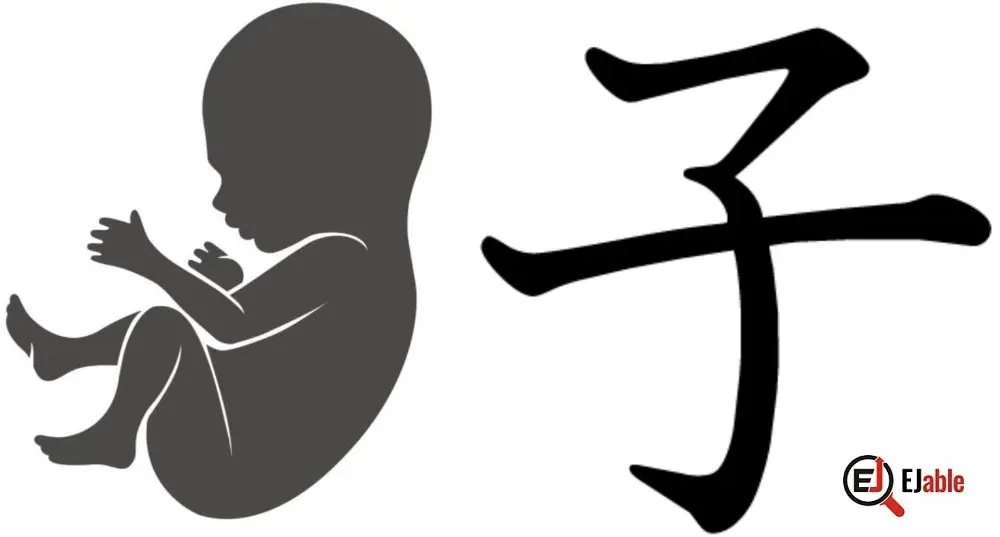
Japanese kanji for “Child” is 子.
The pronunciation of the Kanji 子 is “ko” (こ) in its kun’yomi (Japanese reading) and “shi” (シ) or “su” (ス) in its on’yomi (Chinese reading).
Please note that the Kanji 子, meaning “child,” is also one of the twelve Zodiac animal signs in the Chinese zodiac, representing the rat. Additionally, pronounced as zǐ, it also denotes the North direction (0° or 360°) on ancient Chinese compass.
The Kanji 子 is constructed with 3 strokes. This Kanji is a part of the JLPT N5 syllabus (please check the list of JLPT N5 Kanji). In Japanese schools, this Kanji is taught in grade 1.
Origin of the Kanji 子
The original shape of the Kanji 子 was a simple pictogram of a child with a large head, a small body, and two small hands, typical of a child’s body proportions. Let’s see the evolution of the shape of this Kanji from ancient times to the current:
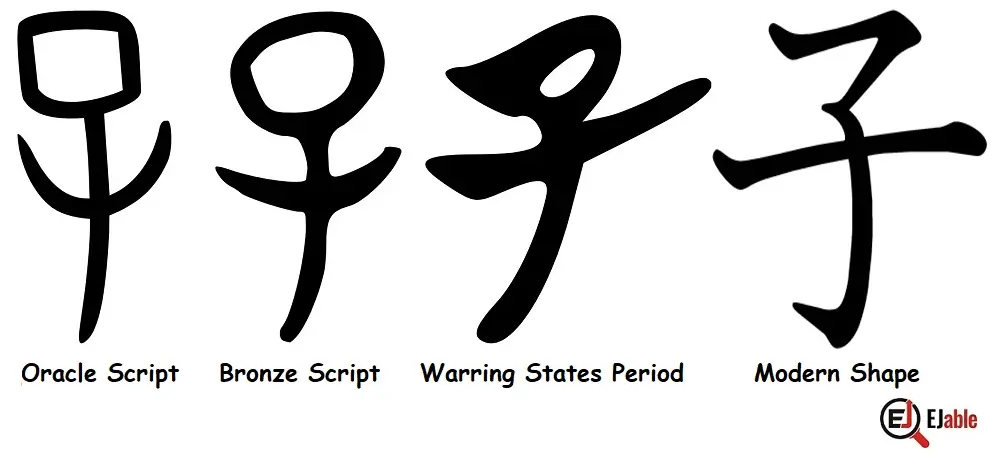
The above image shows the original shape of the Kanji 子 as seen in the old Oracle script, and then in the subsequent phases of Bronze script, warring states period to its evolution to the current shape. Please note that the shape of this Kanji during the warring states period is quite similar to what it is now.
Mnemonic: How to Remember the Kanji for Child (子)
As we saw above, the evolution of the shape of the Kanji 子 has not been extensive. However, the current shape of 子 does not exactly depict a child. Therefore, it is better to have a mnemonic which can make it easier to associate with a child to remember it. So, let’s use the following illustration as a mnemonic to remember 子 by relating it to a child:
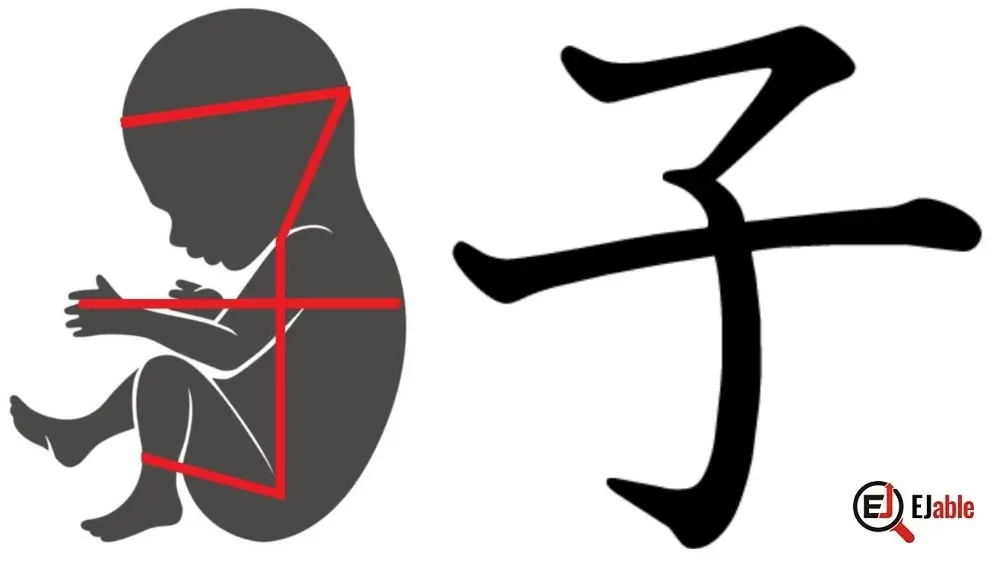
Explanation of the Mnemonic for 子
The above illustration is self-explanatory as a mnemonic for the child’s kanji. Just try to picture a fetus in the womb and associate it with the shape of 子, and you will find it very easy to remember this Kanji.
Stroke Order for the Kanji 子
The following illustrations show the stroke order to write the Kanji 子, meaning “child”:
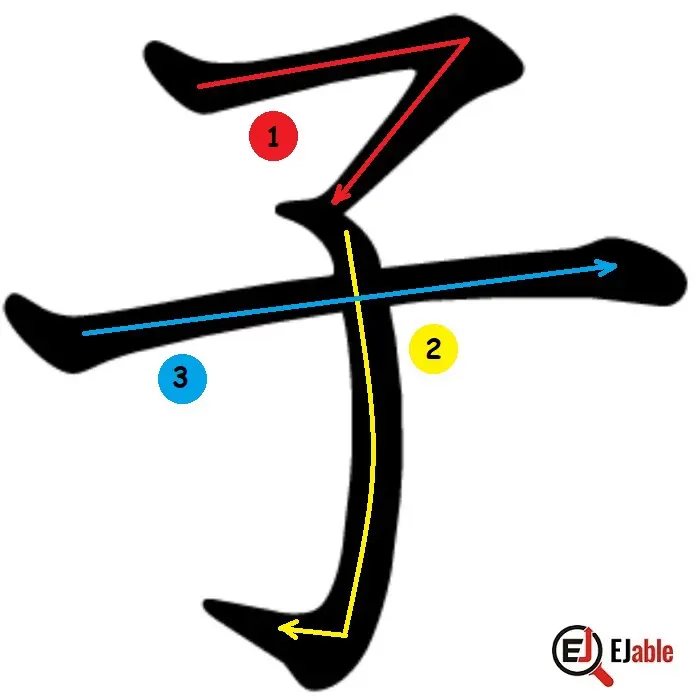
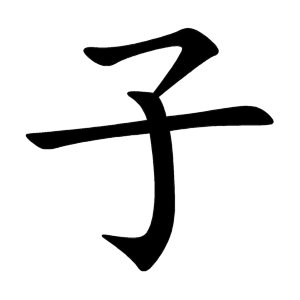
子 as a Radical and Component in other Kanji Characters
Kanji 子 (ko, shi), meaning “child,” is also used as a Kanji radical, in other Kanji characters. When 子 appears as a radical, it often imparts meanings related to children, smallness, or something related to the concept of offspring or youth.
Overall, Kanji 子 appears as a radical or as a component in 145 Kanji characters, including 19 Jōyō Kanji.
Examples of 子 as a radical or component
Following are some examples of kanji where 子 (child) appears as a radical:
The following are some examples of Kanji characters that include the 子 radical or component:
- 好 (こう / kō): Like, fondness.
- 学 (がく / gaku): Study, learning.
- 孔 (こう / kō): Hole, aperture.
- 字 (じ / ji): Character, letter.
- 存 (そん / son): Exist, suppose.
- 孝 (こう / kō): Filial piety.
- 孟 (もう / mō): First, chief.
- 孤 (こ / ko): Orphan, alone.
- 季 (き / ki): Season, period.
- 孫 (そん / son): Grandchild.
In these Kanji, 子 contributes to the overall meaning of the character, often reflecting themes related to youth, smallness, or familial relationships.
Child (Ko) Kanji in Compounded Words
The kanji for “child” 子 (ko, こ) is commonly used in the Japanese language and forms part of many compound words. There are 183 Japanese words that begin with the Kanji 子, and it appears in 2025 words.
Examples of Kanji 子 in Compounded Kanji Characters
Following are the examples where the Kanji for child appears in Japanese compounded Kanji characters:
- 子供 (こども / kodomo): Child, children.
- 女子 (じょし / joshi): Girl, female.
- 男子 (だんし / danshi): Boy, male.
- 子猫 (こねこ / koneko): Kitten.
- 子犬 (こいぬ / koinu): Puppy.
- 子孫 (しそん / shison): Descendants, offspring.
- 子宮 (しきゅう / shikyū): Womb, uterus.
- 子育て (こそだて / kosodate): Child-rearing, parenting.
- 幼子 (ようし / yōji on Osanago): Young child, infant.
- 子会社 (こがいしゃ / kogaisha): Subsidiary company.
- 学子 (がくし / gakushi): Student.
- 養子 (ようし / yōshi): Adopted child.
- 子分 (こぶん / kobun): Subordinate, follower.
- 子宝 (こだから / kodakara): Having many children; blessing of children.
- 一人子 (ひとりご / hitorigo): Only child in the family.
The above compound words showcase the use of 子 in various contexts, from describing literal children to metaphorical and relational uses related to a child.
Interestingly, the child’s kanji 子 is very commonly used at the end of Japanese women’s names—for example, Yūko ( 優子, 悠子, 裕子, etc.), Akiko (影子, 晶子, 明子, 秋子, etc.), Yukiko (幸子, 雪子, 由喜子, 由貴子, etc), Hiroko (寛子, 裕子, 浩子, 弘子, etc.), Sachiko (幸子, etc.) and many more.
The “ko” is added to the Japanese girls’ names to indicate childlike qualities of being innocent or naive in a positive way.
Check other Kanji characters on the page “How to Learn Kanji“.

A long-term ex-pat in Japan, Himanshu comes with an IT background in SAP consulting, IT Business Development, and then running the country operations of an IT consulting multinational. Himanshu is the co-founder and Managing Director of ReachExt K.K. and EJable.com. He is also an Advisory Board Member of a Silicon Valley AI/IoT startup.
